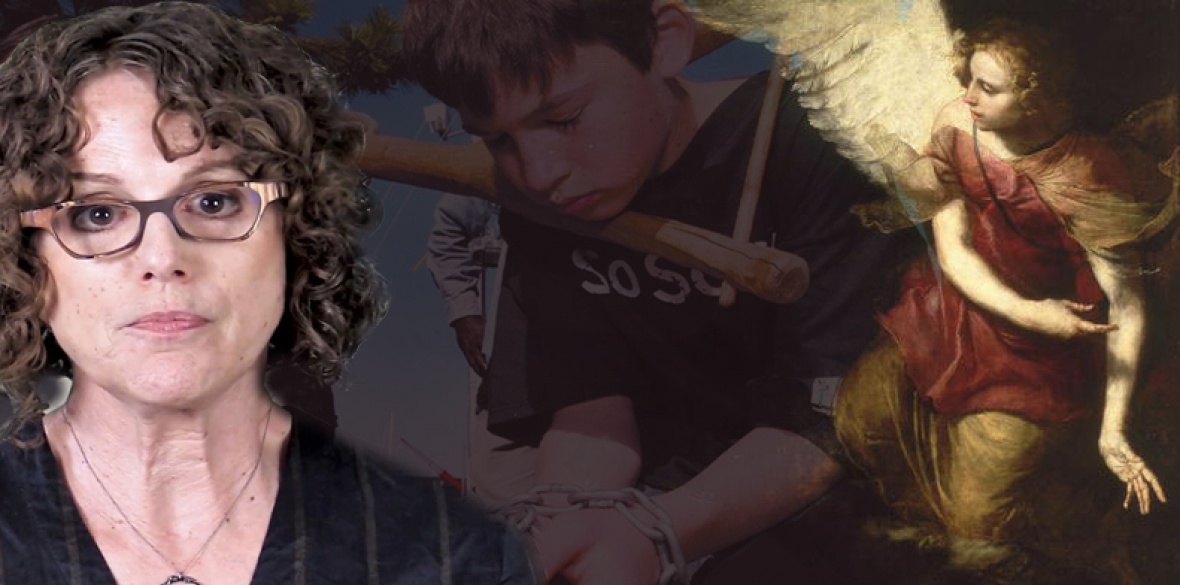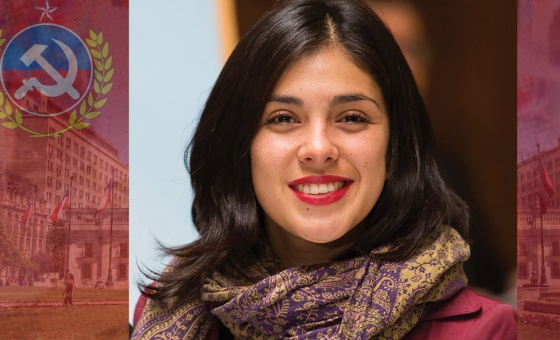This is the last article you can read this month
You can read more article this month
You can read more articles this month
Sorry your limit is up for this month
Reset on:
Please help support the Morning Star by subscribing here
MY local PBS radio station reserves an early hour on Sunday for On Being, a saccharine-sweet mixture of pop-philosophy, psychobabble and pseudo-religiosity hosted by Krista Tippett.
Tippett drips with overly earnest sincerity as she probes guests with questions posed as profound and with deep existential import. While serious thinkers occasionally rotate through her show, more than a few of her guests are con artists, conjurers or charlatans.
Inevitably, in this time of long-overdue mass resistance to racial violence, Tippett would discover and promote the “work” of Robin DiAngelo, the author of White Fragility, a New York Times best seller and a book enjoying widespread influence and popularity as an anti-racist guide to book clubbers, NGOs, foundations and corporations.
A curious feature of the On Being interview of DiAngelo and Resmaa Menakem, a Minnesota-based therapist and coach and author of My Grandmother’s Hands: Racialised Trauma and the Pathway to Mending Our Hearts and Bodies, is the absence of any reference to the core, structural elements of US racism.
There is much discussion of racially sensitive etiquette and manners, of conflicted identities, of “interpretations, perceptions, emotions, language,” of discomforting conversations and of racial repair — “And the framework that is causing white fragility is a refusal to repair, a refusal to see or feel…”
But there is little or no mention of the material condition of black people, little or no mention of the substance of African-American oppression and little or no discussion of the prerequisites for achieving genuine racial equality.
DiAngelo shows no interest in exposing the material elements of the racial divide. Instead, she trades in perceptions and feelings between the races. There is, for example, no exposure of the ethnic cleansing (gentrification) that today plagues every US city and dislocates hundreds of thousands of African Americans from segregated cities to equally segregated neighbourhoods in de-industrialised suburbs.
Like the indigenous American peoples, African Americans are relocated from poverty-laced, low-income, segregated “reservations” to another poverty-laced, segregated “reservation” in abandoned, formerly white enclaves. The old, former “reservations” are now available at low purchase prices and minimal property taxes to a privileged urban gentry.
DiAngelo shows no interest in this development. Nor does she explore the “white privilege,” the profiteering, or the elite complicity that drives it.
Neither does DiAngelo take note of the persistent wealth and income gap between whites and blacks in the US. Consistently, since 1968, whites accumulate on average 10 times the wealth of their African American counterparts.
This means, of course, that every generation of blacks cannot give the next generation an economic head start, which serves as a multiplier of African American disadvantage. Yet this in-your-face racism apparently escapes DiAngelo.
The wealth gap condemns and forces more and more blacks into often substandard residence in low-income areas that become literal Bantustans, results of the formal (Jim Crow) and informal apartheid policies imposed by the US ruling class since the Civil War. Like South Africa’s former apartheid regime, it is these segregated areas that are maintained decisively by the brutality of police.
These areas, euphemistically referred to by white elites as “the black community” instead of the old pejorative “ghetto,” exist as food deserts, lacking the selection and quality of their white counterparts, but, often, at higher prices. Schools serving blacks are notoriously inferior.
The 1974 Milliken vs Bradley Supreme Court decision institutionalised urban school segregation, legitimising and encouraging white flight to the suburbs and exurbs. There is no mention of this structural racism of education, healthcare, human services or its effects on infant mortality, health outcomes and life expectancy, in the On Being interview.
Nor does DiAngelo decry the criminalisation and mass incarceration that has become a feature of African-American oppression or any of the other features eviscerating the material quality of black life.
Hers is the anti-racism that ignores actual racism.
Commodifying Anti-Racism
Everything can become a commodity in the capitalist mode of production. From ideas to the water that we drink, capitalism strives to incorporate them into the vast commercial marketplace.
Commodification creeps into every aspect of human experience, as an answer to every whim. So it should not be surprising that even ideas like anti-racism should be appropriated, commodified and sold in the marketplace.
In the sixties, anti-racist organisations like the Black Panther Party were laudably able to utilise the white liberal guilt of celebrities and elites to raise funds for socially useful projects like day care, breakfast programmes, tutoring and so on.
But since that time, others have exploited liberal guilt and the perceived need of institutions to appear racially sensitive to establish a veritable diversity industry. Diversity training, the broad field DiAngelo’s product falls into, has a long history, but one of questionable results.
While it may prove lucrative to consultants, lecturers, academics and business types, it has done little, in fact, to desegregate institutions — corporations, foundations or NGOs. In fact, some studies suggest that some institutions have become less diverse after exposure to diversity training.
DiAngelo’s fast-growing speaking and consulting business places her squarely in this tradition. It is strange — to say the least — that this enterprise has encouraged the media to place an academic white woman with no engagement with the long-standing mass anti-racist movement into the role of a leader of anti-racism.
Promoted by the national media, she is an “explainer” of racism in the same way that JD Vance and his book, Hillbilly Elegy, were an “explainer” of the midwestern white working class. In both cases, someone who has “escaped,” who is enlightened, will show the way to understanding for east and west coast urban and suburban elites. Both have profitably opened a book of enlightenment for those uninitiated.
For DiAngelo, the product that she is peddling is “allyship,” a condition won through a rigorous ritual of self-examination and atonement. Supposedly, when white people pass through this ritual, they can then accompany African Americans in the anti-racist struggle.
But not everyone can be your guide: “And it takes years of experience and study and struggle and mistake-making and trust-building to hold a group around race and really hold that group and push them and help them go where they need to go, in ways that are constructive. It takes a lot of experience.” Better call Robin DiAngelo.
It is profoundly revealing that DiAngelo’s anti-racism is not about black people and their condition, but about white people and their condition, their conversations, their attitudes, their feelings, their willingness to confess:
“And even the confession can be problematic. It can range from just a form of masochism to a form of, ‘Well, I feel bad enough that you can see that I’m actually good.’ And so that also becomes performative...”
DiAngelo’s anti-racism is rigidly individualistic, a kind of mentored self-help in becoming a better ally accepted by black people — not a fighter along with black people against the forces of oppression, not a warrior against the wealth and power of those intent upon keeping the black working-class poor and powerless. This is anti-racism without equality at its core.
In its essence, it fails because it rejects the idea of class. It fails to distinguish between the social discomforts of the upper-middle classes — both white and black — and the plight of the African-American working class.
Only a few years have passed since the Obama presidency brought a smug assurance that we were now in a post-racial era because a black elite had grabbed the brass ring.
The smartphone camera-exposed orgy of police violence largely against poor and working-class African Americans challenges that notion. But the DiAngelos and their media promoters give us new hope: we can return to post-racialism if we just get our heads straight!
Meanwhile, the edifice of racism remains intact. Black workers work for lower wages, pay more for the same services, get fewer of the available services, remain segregated and die sooner. The developers, landlords, petty capitalists and CEOs continue to super-exploit African American workers.
The ultimate answer to racism does not lie in exorcism, symbolic gestures, sensibilities or feelings. If racial injustice is not merely about feelings, then certainly anti-racism is not only about attitudes, either.
The genuine anti-racist warriors — black and white — are crafting answers that enrich and empower Black people. They are attacking the wealthy and powerful who benefit from racial oppression. They are holding the oppressive institutions, their leaders and their beneficiaries accountable for the material consequences of racist practices. They centre anti-racism around winning equality. DiAngelo’s exorcisms touch none of this.












